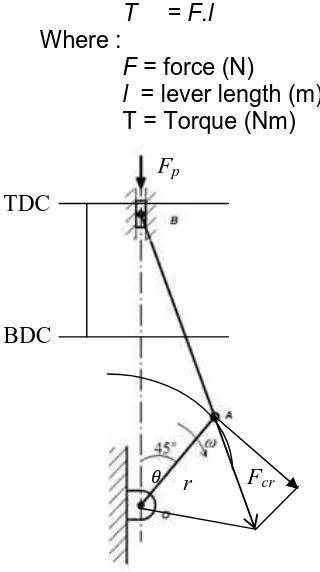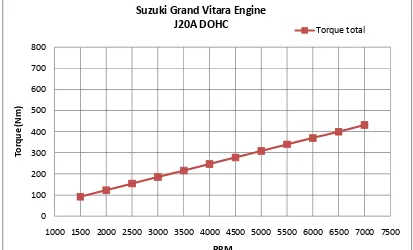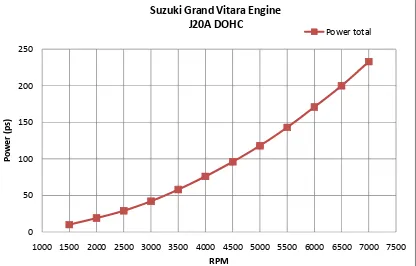1 PAPER
PUBLICATION ARTICLE
POWER ANALYSIS OF GRAND VITARA CAR
This Paper is Submitted as a Partial Fulfillment of the Requirements for Getting the Bachelor Degree of Engineering in Automotive Department
Arranged by CANCAN CANDIANA
D200 090 203
MECHANICAL ENGINEERING DEPARTMENT INTERNATIONAL PROGRAM
IN AUTOMOTIVE/MOTORCYCLE ENGINEERING
MUHAMMADIYAH UNIVERSITY OF SURAKARTA
3
POWER ANALYSIS OF GRAND VITARA CAR
Cancan Candiana
Mechanical Engineering Department International Program In Automotive/Motorcycle EngineeringMuhammadiyah University of Surakarta
Jln. A. YaniPabelan-Kartasura.TromolPos I Telp. (0271) 715448 Surakarta E-mail :cancancancan124@yahoo.com
ABSTRACT
The objective of this research is to know the power engine of Grand Vitara Car.Research uses engine 2.0 liters. Use calculation analysis to know that power of Grand Vitara Car.
The first step to start calculate we collects all the data engine of Grand Vitara Car, diameter of bore, length of stroke, volume of cylinder, and fuel used. After all the data has been collected. Then begins the process of calculation fuel combustion, pressure, torque, and power.
The calculation of the engine analysis of crank angle and pressure, that at crank angle 15o until 180o, the pressure table show is decreased, the engine analysis of crank angle and force, that at crank angle 15o until 180o, the force table show is decreased, the engine analysis of crank angle and torque, that at crank angle 15o until 30o, the torque show is increased, and at crank angle 45o until 180o, the torque show is decreased.
Key words: pressure, power and torque.
Background of The Study
4 designed to be able to pass
through terrain both on road and off road. However, recently classified SUV car does not have to have a 4 wheel drive system or pickup. The car has a powerful engine, great body which can accommodate passengers and freight, and able to be used both Toyota Fortuner, Grand Vitara and Honda CR-V. Discovery, Toyota Highlander, Kia Sorento
c. Full-Size
Full Size SUV: SUV is a car with a large size and represent all the properties of the SUV is equipped with a large,
large size, capable of carrying passengers and goods in large quantities, and is able to traverse both onroad and offroad terrain. Cars that fall into this class of car is the Toyota Landcruiser, Toyota Sequoia, Ford Expedition, Mercedes Benz GL.
Objectives of the Study
According to the problems statement above, the research has some objectives of the study. The objective is to analysis engine power.
a. To know the engine power. b. To know the engine torque.
Benefit of The study
Two benefits of this project study are as follows:
a. Theoretical Benefit
The study is expected to give extra lessons to know about engine Performance.
b. Practical Benefit
The study is expected to learn more the knowledge of researcher and reader about principles mechanisms machine.
Problem Limitations
5 combustion process becoming mechanic energy in the combustion chamber.
A chemical reaction during which a fuel is oxidized and a large quantity is released is called combustion. Combustion is initiated with a spark plug that the air-fuel mixture is consumed
Before the combustion process is fully developed.
Figure1 Components of Basic Combustion
Actually, the compositions of fuel substances are carbon, hydrocarbon, nitrogen, sulfur, oxygen, ash, and moisture. The
(Pulkrabek Willard W,2001)
Petrol (Premium)
Premium gasoline is derived from a fraction of a given petroleum refining additives or additives, that is Tetra Ethyl Lead (TEL).Premium has the empirical formula Ethyl Benzene (C8H18). Premium fuel typesdisilat
is yellow due to the extra dye.The use of premium is generally used to fuel gasoline-powered motor vehicles, such as cars,
Table 3.2 Gasoline Properties
(Source: Laboratory of Oil
Technology, Chemical Engineering,
Gajahmada State University) Fuel Type ‘Premium’
Gasoline
6 Four-Stroke Engine Work
a. Intake Stroke air in a diesel engine, is forced by atmospheric (or greater) pressure into the cylinder through the intake port. The intake valve(s) then close. The volume of air/fuel mixture that is drawn into the cylinder, relative to the volume of the cylinder is called, the volumetric efficiency of the engine.
b. Compression Stroke
With both intake and exhaust valves closed, the piston returns to the top of the cylinder compressing the air, or fuel-air mixture into the combustion chamber of the cylinder head.
c. Expansion Stroke
This is the start of the spark plug, or fuel is injected into the diesel engine, which ignites due to the heat generated in the air during the compression stroke. The resulting massive pressure from the combustion of the compressed fuel-air mixture forces the piston back down toward bottom dead centre.
d. Exhaust Stroke
During the exhaust stroke, the piston once again returns to top dead center while the exhaust valve is open. This action are considered in the analysis of the mechanism, the analysis is known as dynamic force analysis, the analysis of force for one cylinder as follow.
Fp = Pmep .A
7 where :
l = Stroke
r = radius of crank
Radius of crank, r = stroke
Figure 3 Model of vertical cylinder
Force connecting road, Fcr = Fp . sin θ
Torque (T )
The analysis of torque in the experiment is observed by using the data that obtained with calculation analysis. The analysis of torque for one cylinder as follow.
T = F.l Where :
F = force (N)
l = lever length (m) T = Torque (Nm)
Figure 4 Model of vertical cylinder
Figure 5 Model of horizontal
T = F.l
= Fcr.r sin θ
Fcr r
TDC
BDC
Fp
r
TDC
BDC
Fp
Fcr Fp
Fcr sin
8 Figure 4Graphic analysis of torque
From the figure 4, analysis of torque engine shows, that at rotation 1500 rpm, the highest torque generated 92 Nm. On rotation 7000 rpm, the highest torque generated 432 Nm. From the figure 4 can be explained if the value of rpm increase value of torque also increase. The highest torque total from the figure 4 at rpm 7000 is 432 Nm and on spesification the highest torque at rpm 4000 is 183 Nm, this difference is caused the value of mean effective pressure in the engine is constan.
Power
Power is work done that produced by the engine in the experiment, which can be formulated as bellow: (John B, 1988)
P = . . .
where:
P = Power (kW)
n = Engine rotation(rpm)
T = Torque (Nm) 0
100 200 300 400 500 600 700 800
1000 1500 2000 2500 3000 3500 4000 4500 5000 5500 6000 6500 7000 7500
T
o
rq
u
e
(N
m
)
RPM
Suzuki Grand Vitara Engine J20A DOHC
9 Figure 5Graphic analysis of power
From the figure 5, analysis of power engine shows, that at the value of rpm increase value of power also increase. The highest power total from the figure 5 at rpm 7000 is 233 ps and power on spesification at rpm 6000 is 144 ps. This difference is caused the value of mean effective pressure in the engine is constan.
Conclusion
Based on data analysis from the researchs, The conclusions that can be drawn from the experiment are:
a. That at rotation 1500 rpm, the highest torque generated 92 Nm. On rotation 7000 rpm, the highest torque generated 432 Nm. Torque will increase if the value of rpm increase.
b. That at rotation 1500 rpm, the highest power generated 10 ps. On rotation 7000 rpm, the highest power generated 233 ps. Power
d. Torque total analysis at rpm 4000 is 246 Nm and torque on
1000 1500 2000 2500 3000 3500 4000 4500 5000 5500 6000 6500 7000 7500
P
Suzuki Grand Vitara Engine J20A DOHC
10 Suggestion
From the experiment that has been done by researcher, here researcher want to give some suggestions for the better in next experiment:
a. The engine that used in the research should be in normal condition to
get the optimal performance of the engine.
b. We should to have more data engine as possible to begin the analysis.
11 Refferences
Basu, P. 2006. Combustion and Gasification in Fluidized Beds. LLC: Taylor & Francis Group.
Çengel, Y. A., & Boles, M. A. (2006).Thermodynamics: An Engineering Approach 5th ed. McGraw-Hill Higher Education.
Ganesan, V, 2003. Internal Combustion Engine Second Edition. Tata McGraw-Hill. New Delhi.
Graham B. A. 1981, Performance Tuning In Theory & Practice, Hynes Publishing Group, England.
Harjono.1987, “TeknologiMinyakBumi I, BukuPanduanTeknik Kimia”, Universitas Gajah Mada, Jogjakarta.
John B, 1988, Internal Combustion Engines Fundamentals, McGraw-Hill inc, New York.
Jauhari, E. 2005.
“AnalisisPemanasanBahanBakarTerhadapUnjukKerjaMesinBensin”.TugasAkhir S-1, TeknikMesin, UniversitasMuhammadiyah Surakarta.


